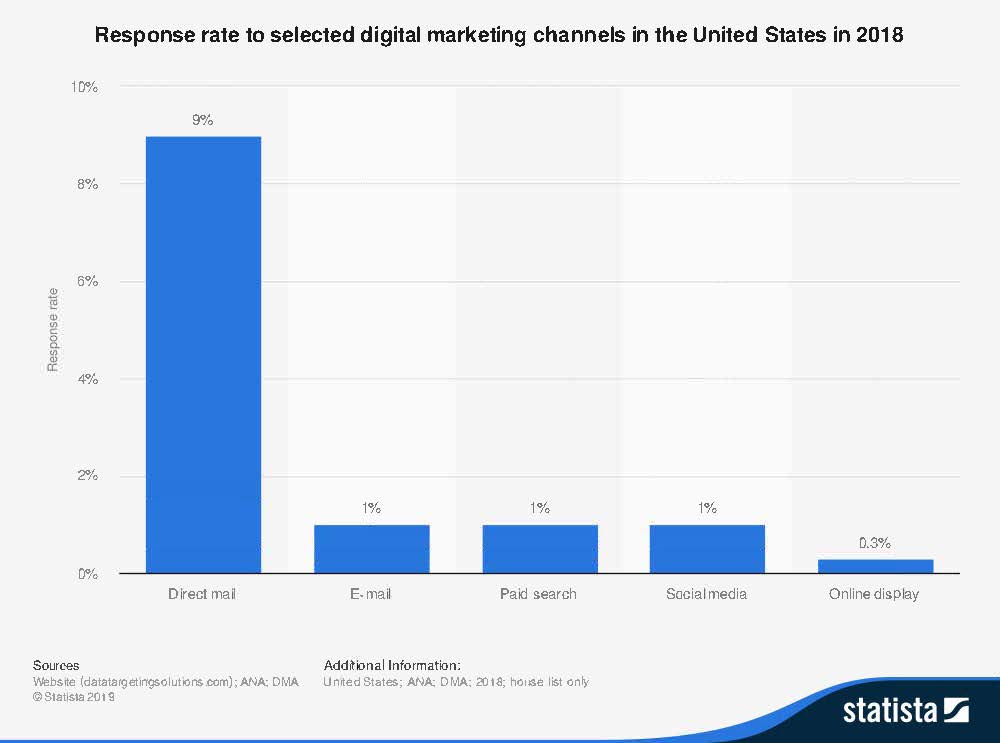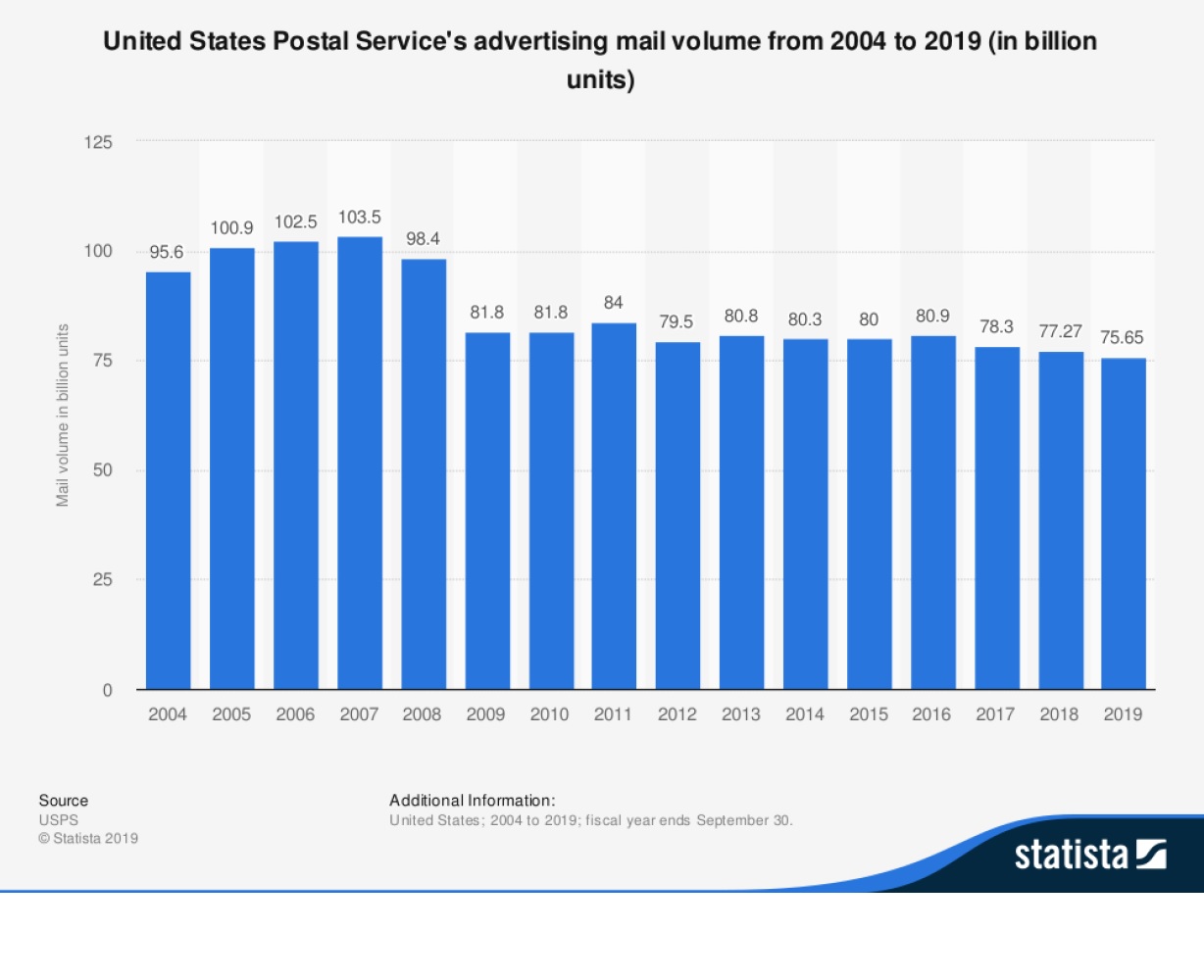Updated May 21, 2020
Direct Mail Marketing
The phrase “Direct mail is dead” has been running around for some time. It comes up time and time again as companies shift their dollars towards online/digital marketing initiatives. With the cost of postage increasing and the volume of physical mail traveling through USPS continuing to decrease, it’s easy to fall into the trap of thinking that direct mail marketing doesn’t work.
The truth is, direct mail is more effective than ever. When you drill down into the statistics, there’s a clear story to tell—how direct mail can work for you, especially in terms of response rate. Direct mail marketing consistently outperforms email, paid search, social media and online display in terms of response rates: 9% versus 1% or less.
(Table 1 – Guttman, 2019)
More Attention
It’s no secret that there’s less mail processing through the USPS, year after year, amounting to a 26% decrease since 2007. The reasons are pretty easy to see, too—more companies and consumers choosing “paperless” statements and bill pay options, companies pulling back on their print budgets. Additionally, with new options for data collection that allow better targeting and personalization, there is less Every Door Direct Mail (EDDM) saturating entire postal routes.
The Decrease in Mail Volume is a Great Thing for Message Exposure
Though email open rates hover around 20% (depending on your industry), studies show that the overwhelming majority of people, including 84% of millennials, sort their physical mail and review it immediately. As of 2018, the average person receives more than 100 emails per day, compared to only 2 pieces of mail. As a result, emails very quickly move out of the line-of-sight at the top of your inbox. Compare this to a physical piece of mail that you can set aside until you’re ready for it without 100 messages a day piling up on top!
Thus, compared to online avenues, you’ve already succeeded at a major challenge—getting the recipient to see or truly look at your message.
Better Response
Response rates from direct mail initiatives consistently outperform digital advertising methods, and not by small margins. As the onslaught of digital ads continues to increase—from banner ads, to search ads, to email marketing, to you name it—direct mail’s performance has only gotten better. The average response rate from a house list is 9%, up 173% since 2006. Average response from a prospect list is 5%, up 194% since 2006. Compare this to digital marketing response rates, which peak at 1% (and some don’t even come close to that high). Industry research shows that 79% of consumers act on direct mail immediately, compared to email’s 45%—showing that not only does direct mail outperform, but the response is faster.
Even better, adding just name personalization to direct mail can increase your response rate by 135%, while other targeted messaging can boost by another 50%. Direct mail personalization is almost limitless with current technology, including customized text, image, colors, and more based on your unique database!
Lasting (and Positive!) Impression
Research shows that holding and physically engaging with a piece helps a recipient retain the information, increases desirability and creates a more positive perception of the brand. In 2017, a study by the USPS found that our brains are 20% more engaged when viewing print advertising. This translates to memory, too—according to the DMA, the tangibility of a physical mailer helps the recipient understand and remember: it requires 21% less cognitive effort to process direct mail, and recall is 70% higher on a printed, physical mailer compared to a digital ad.
Additionally, most people feel that physical mail is more trustworthy, compared to the onslaught of digital spam that can be hiding malware or malintentions. Direct mail feels more credible, partially because it is a less saturated market than digital advertising, and recipients can tell that you are more invested in them when you engage them with a physical piece of mail.
What it all means …
In summary, if you want to spend your marketing dollars in an area with lower response rates and more competition, maybe direct mail isn’t for you. But if you’re like many of our clients and are striving for better strategy, better response, and better ROI, don’t discount direct mail. Share these great reasons to keep direct mail in your 2019 marketing budget!
If you need assistance with a direct mail strategy or multi-channel approach, contact our marketing team today.
Want to download these statistics as an infographic to share or save? Find it here!
*Unless otherwise mentioned, all statistics mentioned are from the Data Marketing & Analytics (DMA), including the 2018 DMA Response Rate Report and the 2018 DMA Statistical Fact Book.
Sources:
Guttman, A. (2019). Table 1: Response Rate to Selected Digital Marketing Channels in the U.S. in 2018. Survey: ANA/DMA Response Rate Report 2018. Retrieved from https://www.statista.com/statistics/1030527/us-response-rate-select-media-digital-marketing/
Mazareanu, E. (2019). Table 2: United States Postal Service’s advertising mail volume from 2004 to 2019 (in billion units). United States Postal Service 2019 Annual Report on Form 10-K, page 20. November, 2019. Retrieved from https://www.statista.com/statistics/320243/advertising-mail-volume-of-the-usps/

